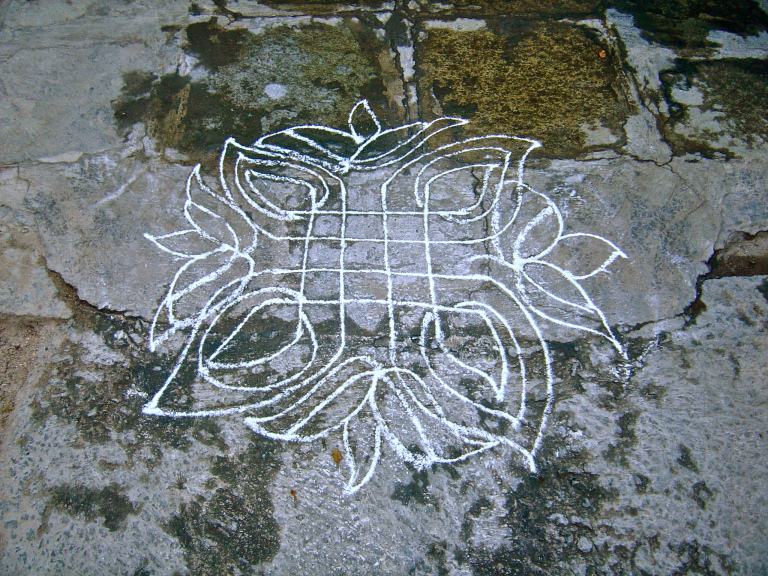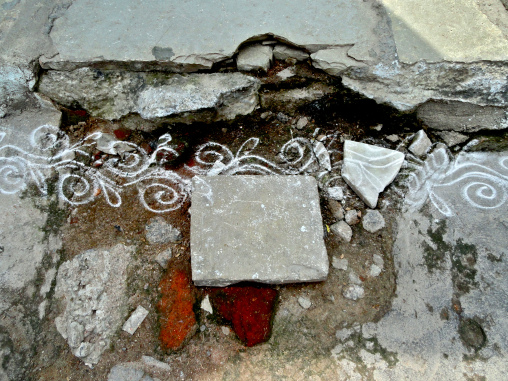Rangoli
Rangoli is a traditional women’s art form common in Hindu households throughout southern India. Designs are drawn directly on the ground and entranceways as part of a ritualistic religious practice. The front steps, entrance, and walkways of buildings are properly cleaned and then decorated with designs and patterns made with chalk powders. There are a remarkable variety of styles and motifs which vary according to the tribal groups and festivals.
The activity is a welcoming of deities into the home or space. In particular, the way is prepared to welcome Lakshmi, the goddess of good fortune but many gods and powers are honored. The activity of drawing the forms is a religious rite and the devotional intention is more important than the end product. The temporary nature of the designs make it clear that the significance is in the deed for it is not creating an object to be held aside and preserved. The designs are quickly lost to the passing of feet, wheels and paws, fading into the dust and bustle of daily life and the ritual of washing and drawing is rhythmically repeated, particularly on auspicious days.
It is one example of the blending of religious practice and art within the rhythms of daily life that are found quite commonly throughout traditional Indian culture. Unfortunately, rapid urbanization and westernization are negatively impacting this remarkable tradition. However, even in an urban environment of modern apartment living the tradition continues on for the blending of religion, art, and everyday life is very much at the heart of Indian culture.
HOW IS IT MADE?
In the early morning hours when the world is just awakening, the woman of the house begins preparations for the day ahead. Daily rhythms include a thorough sweeping and cleaning around the home as well as the courtyard and entranceways. Special care is given to prepare a particular space for drawing rangoli designs and patterns in front of entranceways and along walkways.
The designs vary according to tribal groups and in terms of complexity and scale, there is a very wide range. Designs are generally done with white chalk powder but all reaches a colorful and exuberant zenith during festival time. The designs are laid out with a regular grid of dots or hatching lines which are developed into a wide host of motifs. Designs using a regular grid of dots are created by either connecting the marks or looping around them.
Designs are built upon basic geometric shapes and are further developed into mandalas of swirling lines flowing, curving, and twisting into complicated knots of undulating, rotating, and repeating patterns. The grids also lend themselves to designs of fixed shapes and mosaic like tessellations of stylized flowers, plants, animals, birds, conch shells, chariots, lamps, and much more. The are also given borders and embellishments of running lines, undulating patterns, and mandala like emblems and symbols.
All the designs have an underlying wholeness built upon primary geometric shapes such as circles, squares, hexagons, octagons, and a very wide range of running forms, spirals, rotations, and looping patterns. Most commonly, a simple motif or shape will be rotated and layered to build up the designs, creating a flowing movement or spiraling gesture. The result is an organic and dynamic balance between the fluidity and movement of the hand and the fixed order and determined boundaries of direct line and shape.
The remarkably diverse forms reflect the expressive and devotional impulses of the women who make them. The variety of designs while traditional in origin, often have a very personal character and are a result of the creative vitality working to enliven the energies that connect earthly and cosmic forces. From a social perspective, rangoli is an outward sign that “this is a proper household where the gods are honored”.
Patterns are taught to girls by their mothers and by the time they are young brides, their skills with this art form are most impressive. Quite naturally, the rhythmic nature of the activity leads to some highly developed skills in terms of draftsmanship, control of hand, and balance of form.
But, all things return to the earth and the designs quickly fade into the scuff and dust of comings and goings, creating another layer to the cycles of daily life. Over the past decade, I have marveled at this Hindu practice, appreciating it’s many creative and dynamic forms as well as it’s devotional intentions. This common, everyday aspect of Indian life is a rich artistic and social tradition which imbues spaces with positive intention, heightened purpose, and deeper significance, as well as beautifying the meeting of public and private spaces. As an artist and teacher, I have been fascinated and inspired by the creativity, the endless variety, and sheer beauty of this powerful and dynamic art form.
[Source: D. Nikias]
Click here for more information and wonderful photographs
Something that should be pondered about and celebrated





Intriguing and beautiful!
LikeLiked by 1 person
It is, isn’t it? So Unknown in the west. So inspiring to me.
LikeLiked by 1 person
love it 🙂
LikeLike
I know, it is fantastic, right?!!!
LikeLiked by 1 person
I loved seeing these beautiful doorways every morning while visiting Pondicherry. They truly make every house feel magical. 🙂
LikeLiked by 1 person
Thank you, Shelley. I am quite fascinated with them. Also it is their transience, that makes them so very special.
LikeLiked by 1 person
Wow, amazing!
LikeLike
Would be nice to have artwork sprinkled around our doorsteps. How civil to do that. I am always amazed how the rituals at waking are being performen in so many countries..
The sound of sweeping so soothing.
Here we often have petrol leaf blowers and lawn mowers. Dreadful sounds.
LikeLike
I had not thought about sweeping like that, but it is much more pleasant as well as being environmentally friendly.
LikeLike
I am from south India, where these colors decorate the houses throughout the year. On occasions, these scale to greater designs and decorations. Early morning rituals of the hindus include this drawing patters.
If you look at a woman drawing a Rangoli, it’s very impressive. They don’t draw the lines, the design starts with placement of the dots and the design is to connect these dots. 8 dots will make enough design with its possible joints.
The other ingredient used to draw rangoli is rice. Rice and other crops, to my knowledge, are powdered and used to create rangoli. The intention here is to feed the birds. The birds could eat off the grains. Thoughtful.
LikeLiked by 1 person
This is excellent information Farid, and I thank you most sincerely for providing this valuable insight into the process of making Rangoli. One can see the geometry within these designs, and I think it is that symmetry that draws the eye around the design. Is there variations to the pattern of 8 dots. For example in a trailing border, or a triangular shape that might only have 5 dots?
LikeLiked by 1 person
You’re welcome. It’s very complicated to understand that a design is made out only of 8 dots. The mathematics is getting worsted into this simple 8 dots combination. Probability you know !
It’s not infinite though. Thee are more than 8 dots formation. This goes back in time. The time to when these practices were thought and applied in practice.
LikeLiked by 1 person
It is something I think I will experiment with, in my own way with limited knowledge and the photographs I’ve seen on the net.
LikeLike
Thank you for sharing this. Beautiful
LikeLike
I think so too. Appreciate your comment.
LikeLike
The designs are very beautiful and a wonderful way of welcoming guests to any household. In many ways, it’s a pity they are such temporary things. I had never heard of Rangoli, so thank you for sharing this, Amanda.
LikeLike
I agree,Millie. It is sad that they disappear so quickly, but rather nice that there is a blank canvas each day!
LikeLike
Yes, I can appreciate that side of it, too. A blank canvas always lends itself to a certain freshness – and sometimes improvement on the one done previously.
LikeLiked by 1 person
Yes, the day starts with drawing of the rangoli in many parts of South India. Girls learn how to make them very early and in schools there are rangoli competitions. Maybe you will like this photo:) Regards, Lakshmi Bhat
https://mukhamani.wordpress.com/2015/03/05/a-word-a-week-photograph-challenge-intricate/
LikeLiked by 1 person
A Rangoli competition. That is a wonderful way to encourage the creativity and preservation of the art form in young girls!!! I really love this tradition of Rangoli and thank you from the bottom of my heart for taking the time to show me another gorgeous design. It is very inspirational. Do young men often draw them as well?
LikeLike
Thank you, yes men draw too, but as a matter of custom or tradition, women draw it. In different religious functions, the priests make the rangoli,but it is called a mandala. They are beautiful.You can Google Mandala or Surya mandala. Surya means Sun . Regards:) Lakshmi Bhat
LikeLiked by 1 person
Thanks so much for that additional information
LikeLike